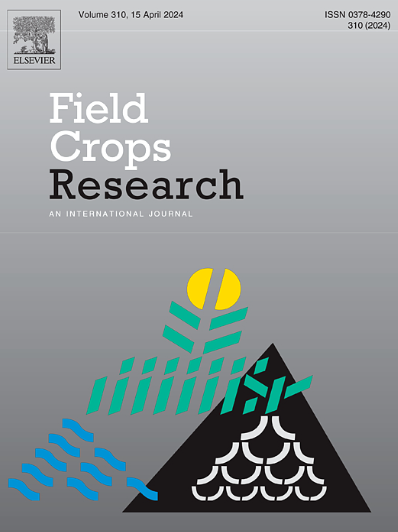间作与低外源投入综合治理对玉米夜蛾的影响
IF 5.6
1区 农林科学
Q1 AGRONOMY
引用次数: 0
摘要
摘要秋粘虫(FAW)或Spodoptera frugiperda是一种多食性入侵害虫,对印度的玉米作物具有破坏性。农民们正采取不分青红皂白地使用杀虫剂来控制它。仅仅依靠化学杀虫剂是不经济的,也是不可持续的。此外,实行单作鼓励虫害发生,而间作创造了作物多样性并提供了自然控制。因此,必须确定环境和经济上可持续的虫害管理办法。目的通过实现低外部投入的害虫综合治理(LEIIPM)和通过间作促进作物多样性,建立一个具有较高昆虫学、农学和经济效益的管理系统。方法通过与化学防治和未处理防治进行比较,评价利用低投入的额外钾肥施用、预防措施、生物防护措施及其与LEIIPM模块相结合的防治效果。这些处理在三种种植系统中实施,即玉米单一作物、玉米+豇豆(1:2)和玉米+鸽豆(2:1)。每隔一周监测害虫发生情况,记录绝对幼虫数量、叶片损害情况和天敌(球虫和蜘蛛)数量。根据玉米当量产量(MEY)、土地当量比(LER)和面积时间当量比(ATER)估算了玉米和间作的竞争行为。从边际收益率(MRR)和效益成本比(BCR)两方面对这些系统的经济效率进行了评价。结果玉米与豇豆间作可减少作物营养期(30 %)和生殖期(24.54 %)绝对幼虫数量。当间作鸽豆时,观察到类似的减少。玉米+豇豆系统的天敌种群(球虫和蜘蛛)最高(分别为1.19和0.94),其次是玉米+鸽豆(分别为1.1和0.86)。采用LEIIPM模块的玉米+豇豆体系的经济效益(MEY(58.10)、LER(1.69)和ATER(1.45))以及BCR(1:5.45)和MRR(6.45)均较高。结论以LEIIPM的形式将多种种植制度与非化学方法相结合,在玉米作物中具有适宜的农艺、昆虫学效益和经济效益。结果表明:综合综合治理与玉米多种间作制度相结合,是一种经济有效的害虫治理方法。然而,为了实现有效的管理,需要及时性、计划、提前准备和全区采用。本文章由计算机程序翻译,如有差异,请以英文原文为准。
Impact of intercropping and low-external input integrated pest management on Spodoptera frugiperda (J. E. Smith) in maize
Context
The Fall armyworm (FAW) or Spodoptera frugiperda, an invasive insect pest, is polyphagous and destructive to maize crop in India. Farmers are resorting to the indiscriminate use of insecticides for its control. Solely resorting on chemical insecticides is uneconomical, and unsustainable. Further, practicing monocropping encourages pest incidence while intercropping creates the crop diversity and provides natural control. Thus, it is imperative to identify environmentally and economically sustainable pest management options.
Objective
Achieving a system with improved entomological, agronomical, and economic efficiencies by accomplishing low-external-input integrated pest management (LEIIPM) and promoting the crop diversity through intercropping for the management of S. frugiperda.
Methods
Efficacy of the pest management treatments based on readily available low external inputs such as application of additional K-nutrition, prophylactic measures, biorationals and their integration as LEIIPM module were evaluated in comparison with chemical control and untreated check. These treatments were imposed across three cropping systems viz., sole crop of maize, maize+cowpea (1:2), and maize+pigeonpea (2:1). Insect pest incidence was monitored at weekly intervals by recording absolute larval population, leaf damage, and the natural enemy (Coccinellids and Spiders) population. The competitive behavior of maize and intercrops was estimated in terms of maize equivalent yields (MEY) land equivalent ratio (LER), and area time equivalent ratio (ATER). The economic efficiency of these systems in terms of marginal rate of returns (MRR) and benefit-cost ratio (BCR) was evaluated.
Results
Intercropping maize with cowpea reduced the absolute larval population in the vegetative (30 %) and reproductive stages (24.54 %) of the crop in LEIIPM. A similar reduction was observed when intercropped with pigeonpea. Natural enemy population (coccinellids and spiders) was higher in maize+cowpea system (1.19 and 0.94) followed by maize+pigeonpea (1.1 and 0.86) with LEIIPM module. Agronomic efficiency measured in terms of MEY (58.10), LER (1.69) and ATER (1.45) and economic efficiency in terms of BCR (1:5.45) and MRR (6.45) were higher in maize+cowpea system with LEIIPM module.
Conclusion
Integration of diversified cropping systems with non-chemical approaches in the form of LEIIPM was agronomically suitable, entomologically efficient, and cost-effective in the management of S. frugiperda in maize crop.
Implications
LEIIPM with diversified intercropping systems in maize offers effective and economical insect pest management. However, in order to achieve the effective management, timeliness, planning, preparation in advance and area-wide adoption are required.
求助全文
通过发布文献求助,成功后即可免费获取论文全文。
去求助
来源期刊

Field Crops Research
农林科学-农艺学
CiteScore
9.60
自引率
12.10%
发文量
307
审稿时长
46 days
期刊介绍:
Field Crops Research is an international journal publishing scientific articles on:
√ experimental and modelling research at field, farm and landscape levels
on temperate and tropical crops and cropping systems,
with a focus on crop ecology and physiology, agronomy, and plant genetics and breeding.
 求助内容:
求助内容: 应助结果提醒方式:
应助结果提醒方式:


